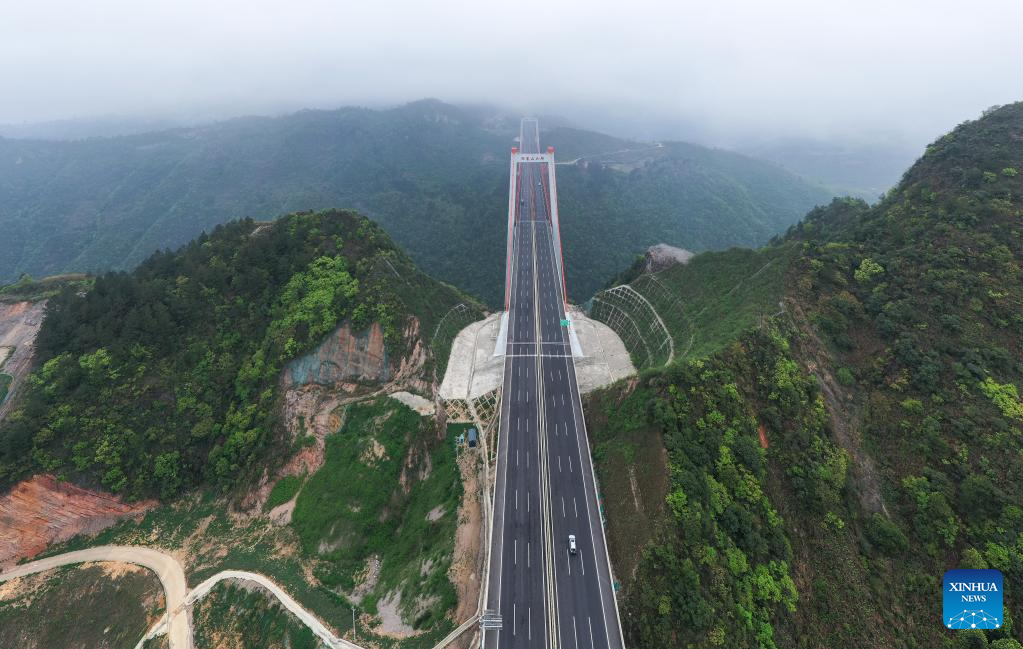
This aerial photo taken on April 11, 2023 shows the Yangbaoshan bridge on the expressway linking Guiyang and Huangping in southwest China's Guizhou Province. Bridges are an unmistakable feature of the transportation infrastructure in Guizhou. With 92.5 percent of its area covered by mountains and hills, the province has built nearly 30,000 bridges since the late 1970s and is now home to nearly half of the 100 tallest bridges in the world.
Thanks to the construction of bridges, the mountainous province is becoming deeply integrated with the nation's transportation network, bringing an improved quality of life for local residents. (Xinhua/Yang Wenbin)
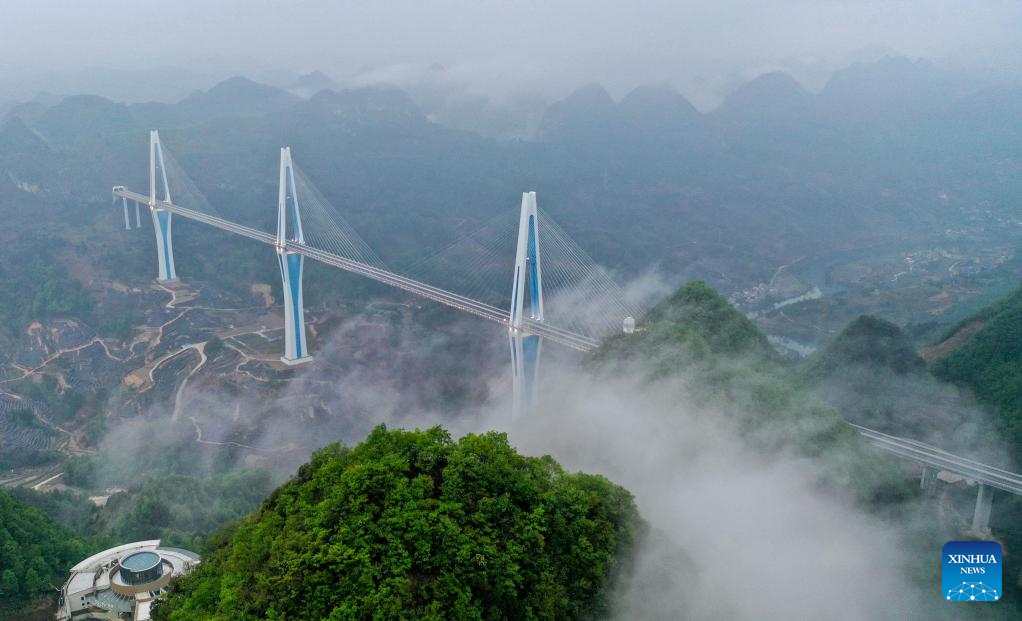
This aerial photo taken on April 14, 2023 shows the Pingtang grand bridge on the expressway linking Pingtang and Luodian in southwest China's Guizhou Province. Bridges are an unmistakable feature of the transportation infrastructure in Guizhou. With 92.5 percent of its area covered by mountains and hills, the province has built nearly 30,000 bridges since the late 1970s and is now home to nearly half of the 100 tallest bridges in the world.
Thanks to the construction of bridges, the mountainous province is becoming deeply integrated with the nation's transportation network, bringing an improved quality of life for local residents. (Xinhua/Yang Wenbin)
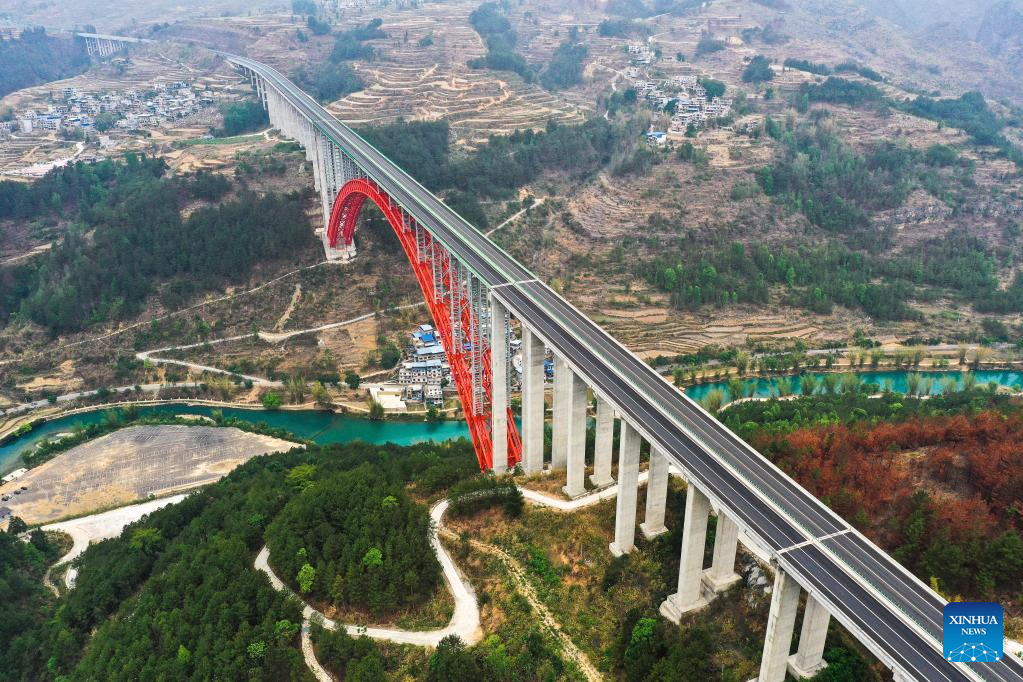
This aerial photo taken on April 14, 2023 shows the Daxiaojing grand bridge on the expressway linking Pingtang and Luodian in southwest China's Guizhou Province. Bridges are an unmistakable feature of the transportation infrastructure in Guizhou. With 92.5 percent of its area covered by mountains and hills, the province has built nearly 30,000 bridges since the late 1970s and is now home to nearly half of the 100 tallest bridges in the world.
Thanks to the construction of bridges, the mountainous province is becoming deeply integrated with the nation's transportation network, bringing an improved quality of life for local residents. (Xinhua/Yang Wenbin)
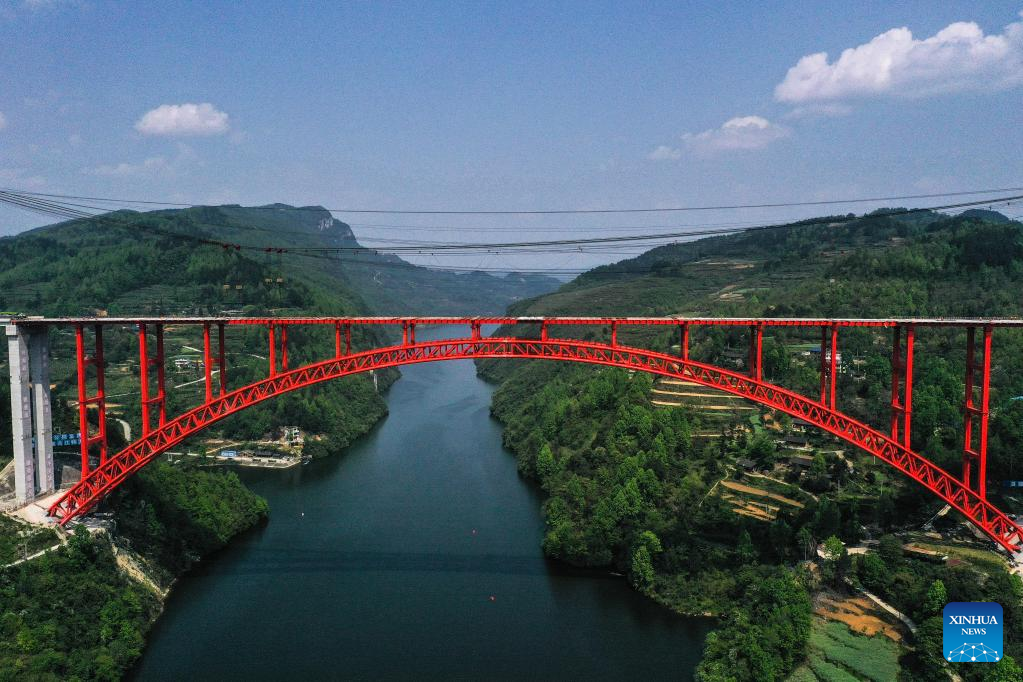
This aerial photo taken on April 11, 2023 shows the construction site of the Wujiang grand bridge on the expressway linking Dejiang and Yuqing in southwest China's Guizhou Province. Bridges are an unmistakable feature of the transportation infrastructure in Guizhou. With 92.5 percent of its area covered by mountains and hills, the province has built nearly 30,000 bridges since the late 1970s and is now home to nearly half of the 100 tallest bridges in the world.
Thanks to the construction of bridges, the mountainous province is becoming deeply integrated with the nation's transportation network, bringing an improved quality of life for local residents. (Xinhua/Yang Wenbin)
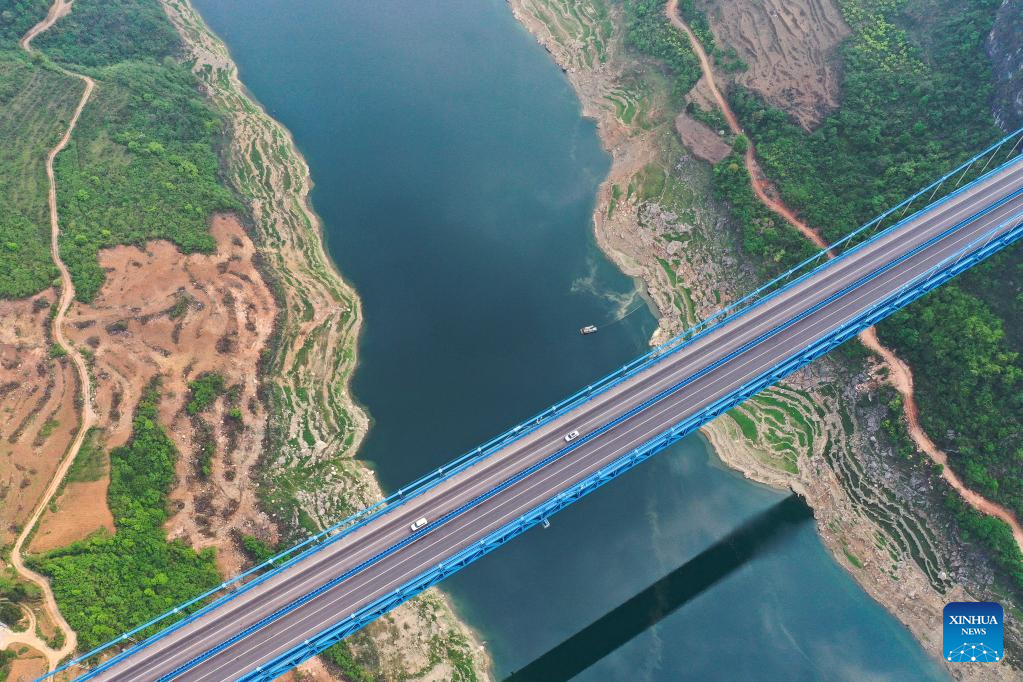
This aerial photo taken on April 13, 2023 shows the Kaizhou Lake bridge on the expressway linking Weng'an and Kaiyang in southwest China's Guizhou Province. Bridges are an unmistakable feature of the transportation infrastructure in Guizhou. With 92.5 percent of its area covered by mountains and hills, the province has built nearly 30,000 bridges since the late 1970s and is now home to nearly half of the 100 tallest bridges in the world.
Thanks to the construction of bridges, the mountainous province is becoming deeply integrated with the nation's transportation network, bringing an improved quality of life for local residents. (Xinhua/Yang Wenbin)
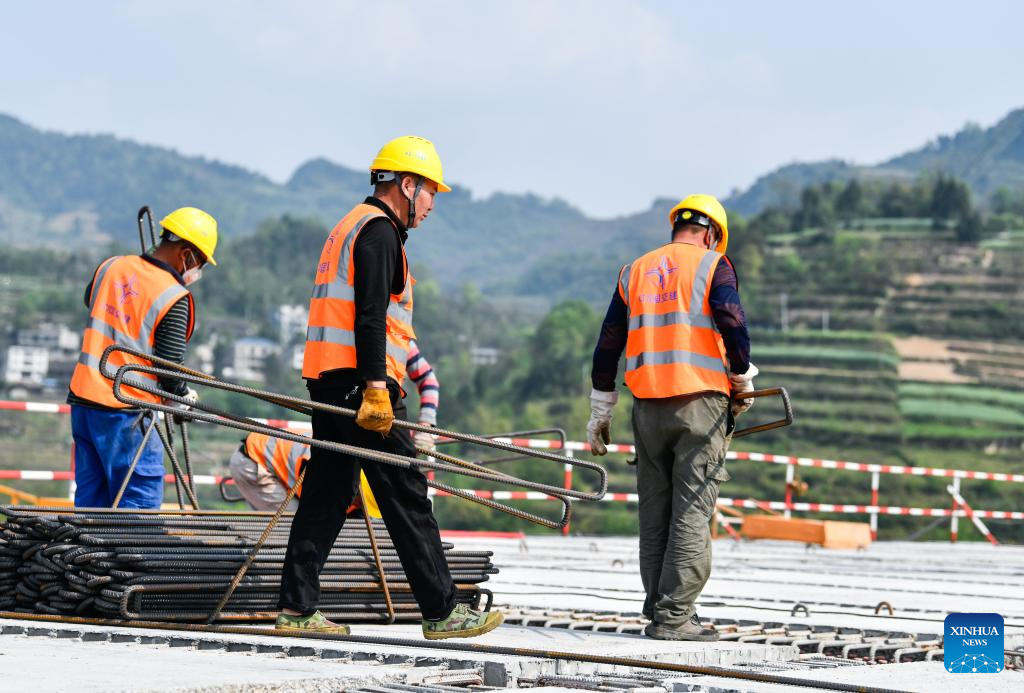
Workers work at the construction site of the Wujiang grand bridge on the expressway linking Dejiang and Yuqing in southwest China's Guizhou Province, April 11, 2023. Bridges are an unmistakable feature of the transportation infrastructure in Guizhou. With 92.5 percent of its area covered by mountains and hills, the province has built nearly 30,000 bridges since the late 1970s and is now home to nearly half of the 100 tallest bridges in the world.
Thanks to the construction of bridges, the mountainous province is becoming deeply integrated with the nation's transportation network, bringing an improved quality of life for local residents. (Xinhua/Yang Wenbin)

This aerial panorama photo taken on April 12, 2023 in southwest China's Guizhou Province shows the construction site of Jinfeng Wujiang River bridge on the expressway linking Guiyang and Jinsha of Guizhou Province and Gulin of southwest China's Sichuan Province. Bridges are an unmistakable feature of the transportation infrastructure in Guizhou. With 92.5 percent of its area covered by mountains and hills, the province has built nearly 30,000 bridges since the late 1970s and is now home to nearly half of the 100 tallest bridges in the world.
Thanks to the construction of bridges, the mountainous province is becoming deeply integrated with the nation's transportation network, bringing an improved quality of life for local residents. (Xinhua/Yang Wenbin)

This aerial photo taken on April 12, 2023 in southwest China's Guizhou Province shows the construction site of Jinfeng Wujiang River bridge on the expressway linking Guiyang and Jinsha of Guizhou Province and Gulin of southwest China's Sichuan Province. Bridges are an unmistakable feature of the transportation infrastructure in Guizhou. With 92.5 percent of its area covered by mountains and hills, the province has built nearly 30,000 bridges since the late 1970s and is now home to nearly half of the 100 tallest bridges in the world.
Thanks to the construction of bridges, the mountainous province is becoming deeply integrated with the nation's transportation network, bringing an improved quality of life for local residents. (Xinhua/Yang Wenbin)
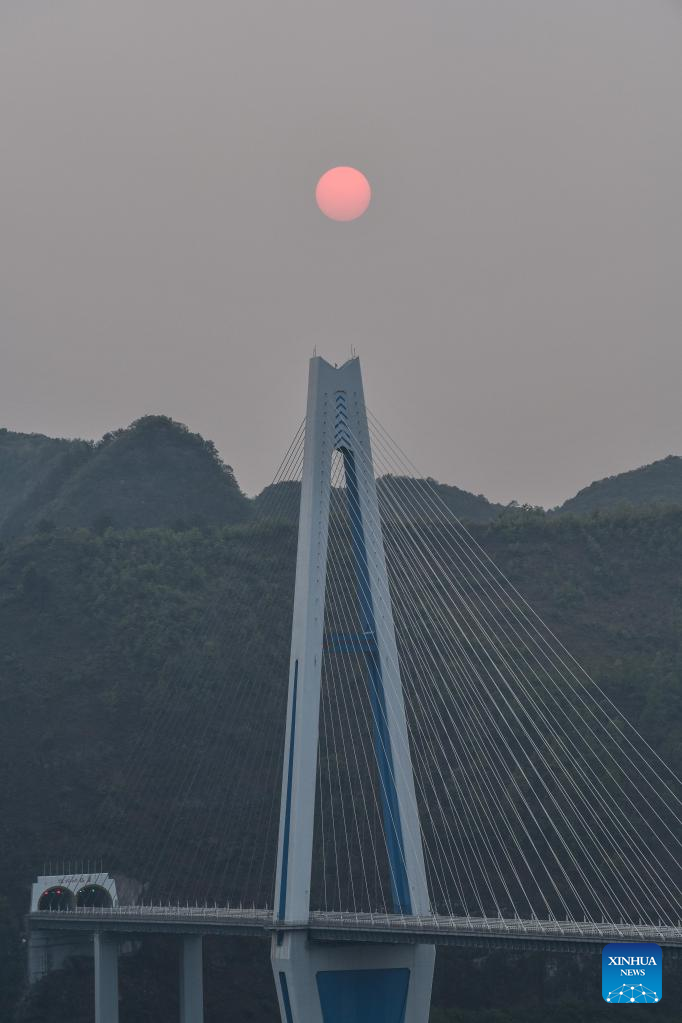
This aerial photo taken on April 13, 2023 shows the Pingtang grand bridge on the expressway linking Pingtang and Luodian in southwest China's Guizhou Province. Bridges are an unmistakable feature of the transportation infrastructure in Guizhou. With 92.5 percent of its area covered by mountains and hills, the province has built nearly 30,000 bridges since the late 1970s and is now home to nearly half of the 100 tallest bridges in the world.
Thanks to the construction of bridges, the mountainous province is becoming deeply integrated with the nation's transportation network, bringing an improved quality of life for local residents. (Xinhua/Yang Wenbin)

This aerial photo taken on April 13, 2023 shows the Pingtang grand bridge on the expressway linking Pingtang and Luodian in southwest China's Guizhou Province. Bridges are an unmistakable feature of the transportation infrastructure in Guizhou. With 92.5 percent of its area covered by mountains and hills, the province has built nearly 30,000 bridges since the late 1970s and is now home to nearly half of the 100 tallest bridges in the world.
Thanks to the construction of bridges, the mountainous province is becoming deeply integrated with the nation's transportation network, bringing an improved quality of life for local residents. (Xinhua/Yang Wenbin)

A welder works at the construction site of the Wujiang grand bridge on the expressway linking Dejiang and Yuqing in southwest China's Guizhou Province, April 11, 2023. Bridges are an unmistakable feature of the transportation infrastructure in Guizhou. With 92.5 percent of its area covered by mountains and hills, the province has built nearly 30,000 bridges since the late 1970s and is now home to nearly half of the 100 tallest bridges in the world.
Thanks to the construction of bridges, the mountainous province is becoming deeply integrated with the nation's transportation network, bringing an improved quality of life for local residents. (Xinhua/Yang Wenbin)

This aerial photo taken on April 13, 2023 shows the Pingtang grand bridge on the expressway linking Pingtang and Luodian in southwest China's Guizhou Province. Bridges are an unmistakable feature of the transportation infrastructure in Guizhou. With 92.5 percent of its area covered by mountains and hills, the province has built nearly 30,000 bridges since the late 1970s and is now home to nearly half of the 100 tallest bridges in the world.
Thanks to the construction of bridges, the mountainous province is becoming deeply integrated with the nation's transportation network, bringing an improved quality of life for local residents. (Xinhua/Yang Wenbin)
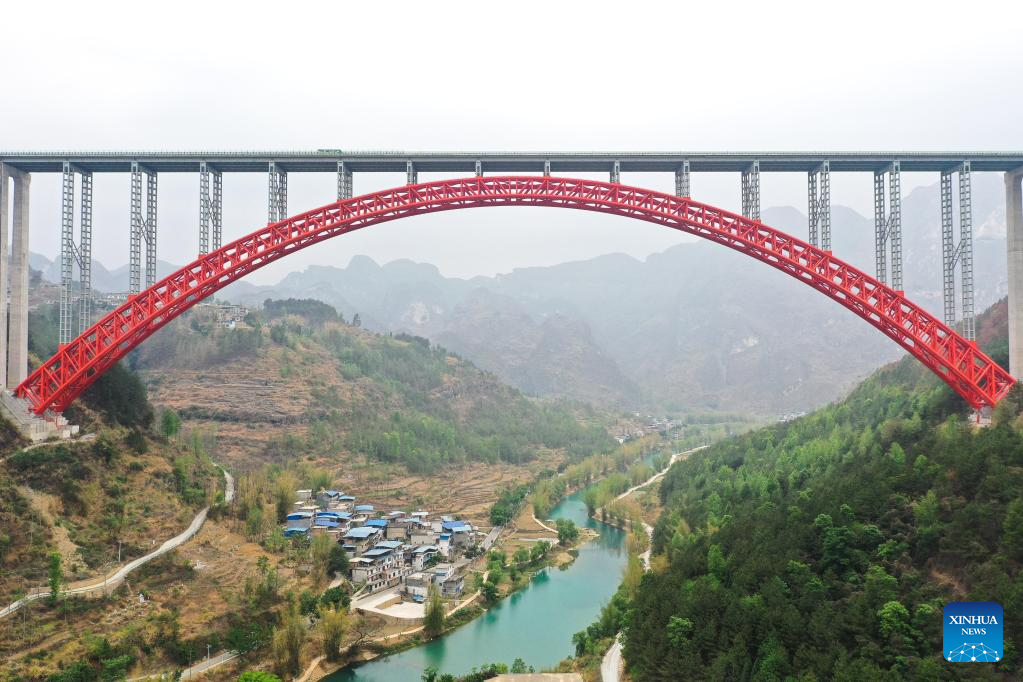
This aerial photo taken on April 14, 2023 shows the Daxiaojing grand bridge on the expressway linking Pingtang and Luodian in southwest China's Guizhou Province. Bridges are an unmistakable feature of the transportation infrastructure in Guizhou. With 92.5 percent of its area covered by mountains and hills, the province has built nearly 30,000 bridges since the late 1970s and is now home to nearly half of the 100 tallest bridges in the world.
Thanks to the construction of bridges, the mountainous province is becoming deeply integrated with the nation's transportation network, bringing an improved quality of life for local residents. (Xinhua/Yang Wenbin)

This aerial photo taken on April 11, 2023 shows the construction site of the Wujiang grand bridge on the expressway linking Dejiang and Yuqing in southwest China's Guizhou Province. Bridges are an unmistakable feature of the transportation infrastructure in Guizhou. With 92.5 percent of its area covered by mountains and hills, the province has built nearly 30,000 bridges since the late 1970s and is now home to nearly half of the 100 tallest bridges in the world.
Thanks to the construction of bridges, the mountainous province is becoming deeply integrated with the nation's transportation network, bringing an improved quality of life for local residents. (Xinhua/Yang Wenbin)
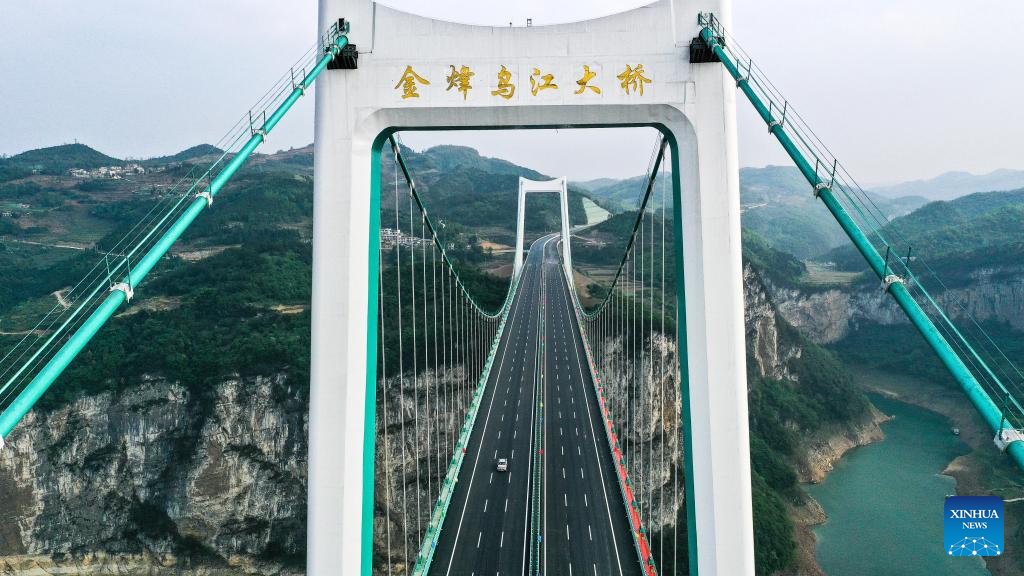
This aerial photo taken on April 12, 2023 in southwest China's Guizhou Province shows the construction site of Jinfeng Wujiang River bridge on the expressway linking Guiyang and Jinsha of Guizhou Province and Gulin of southwest China's Sichuan Province. Bridges are an unmistakable feature of the transportation infrastructure in Guizhou. With 92.5 percent of its area covered by mountains and hills, the province has built nearly 30,000 bridges since the late 1970s and is now home to nearly half of the 100 tallest bridges in the world.
Thanks to the construction of bridges, the mountainous province is becoming deeply integrated with the nation's transportation network, bringing an improved quality of life for local residents. (Xinhua/Yang Wenbin)



